SYSTEMATIC CONSERVATION PLANNING FOR ECOSYSTEM SERVICES: OPPORTUNITIES FOR IMPROVING SPATIAL TARGETING OF ECOSYSTEM SERVICE PAYMENTS IN COSTA RICA
Ramos Bendaña, Zayra Sherlly. (2016). SYSTEMATIC CONSERVATION PLANNING FOR ECOSYSTEM SERVICES: OPPORTUNITIES FOR IMPROVING SPATIAL TARGETING OF ECOSYSTEM SERVICE PAYMENTS IN COSTA RICA. Theses and Dissertations Collection, University of Idaho Library Digital Collections. https://www.lib.uidaho.edu/digital/etd/items/ramosbendaxf1a_idaho_0089e_11032.html
- Title:
- SYSTEMATIC CONSERVATION PLANNING FOR ECOSYSTEM SERVICES: OPPORTUNITIES FOR IMPROVING SPATIAL TARGETING OF ECOSYSTEM SERVICE PAYMENTS IN COSTA RICA
- Author:
- Ramos Bendaña, Zayra Sherlly
- Date:
- 2016
- Keywords:
- carbon storage conservation networks environmental heterogeneity geophysical diversity secondary forest tropical forest
- Program:
- Natural Resources
- Subject Category:
- Natural resource management; Ecology; Remote sensing
- Abstract:
-
Tropical forests are of high conservation priority world-wide due their high value for harboring biodiversity and providing ecosystem services from the local to global scale. Financial resources for conservation are scarce. This challenges practitioners to design conservation networks encompassing spatial synergies between biodiversity and ecosystem services. Furthermore, conservation networks need to be robust to climate change impacts and the unpredictability of biodiversity response to these impacts. Methodologies for selecting locations that can help achieve multiple conservation objectives and can be easily integrated in current conservation practices are urgently needed. The first chapter of this study was focused on exploring the effect of integrating into conservation assessments two climate adaptation approaches based on environmental heterogeneity, as well as the effect of the selection of planning unit size on resultant conservation networks. With Costa Rica as planning region, our results showed that protecting the representation of the geophysical diversity resulted in conservation networks with over 25% more internal environmental heterogeneity, but more fragmented. Incorporating cross-environmental connectivity, on the other hand, resulted in low increases in environmental heterogeneity. Increasing the planning unit size reduced the effect of emphasizing connectivity between environmentally different locations. These results highlight the importance of testing environmental-heterogeneity-based approaches in each context due the specific characteristics of planning regions prior integrating them into formal conservation assessments. The second chapter focused on exploring synergies between biodiversity and carbon storage priorities, when integrating environmental-heterogeneity-based climate adaptation approaches. Results revealed very low synergies between targeting the representation of regional biodiversity and areas of high carbon content. However, spreading out across the country the selection of carbon priority areas by adding stratification improved the synergies with biodiversity priorities, and revealed locations that could be considered priorities for carbon storage in the distribution range of Dry Tropical Forests; one of the most threatened tropical ecosystem. The extent of gains for co-benefits between carbon-related ES and biodiversity conservation will depend in part on how priority areas are selected for implementing strategies, such as PES and REDD, and will determine the location and amount of tropical forest to be conserved. As indicated by the recent development of the spatial data used in Chapter 2, improving spatial datasets for supporting ES targeting is critical in tropical dry forests. As a result, we developed new phenological approaches to map tropical dry forest type using multitemporal Landsat 8 Operational Land Imager data. The major gains in mapping accuracy realized by the multitemporal analysis bodes well for the future of landscape level ES planning in tropical dry forest. Finally, the promising progress in the detection of functional traits through remote sensing offers further opportunities to improve on the quality of the inputs for the mapping of ES, a topic covered in Chapter 4.
- Description:
- doctoral, Ph.D., Natural Resources -- University of Idaho - College of Graduate Studies, 2016
- Major Professor:
- Vierling, Lee A
- Committee:
- Imbach, Pablo A; DeClerck, Fabrice; Jones, Kelly
- Defense Date:
- 2016
- Identifier:
- RamosBendaxF1a_idaho_0089E_11032
- Type:
- Text
- Format Original:
- Format:
- application/pdf
- Rights:
- In Copyright - Educational Use Permitted. For more information, please contact University of Idaho Library Special Collections and Archives Department at libspec@uidaho.edu.
- Standardized Rights:
- http://rightsstatements.org/vocab/InC-EDU/1.0/

